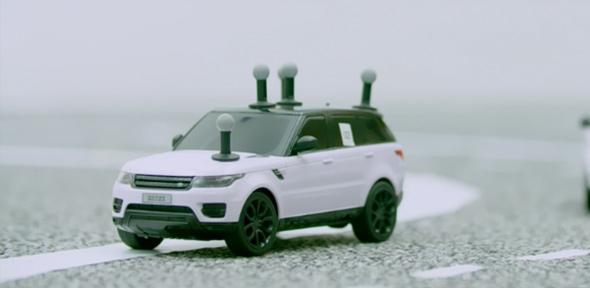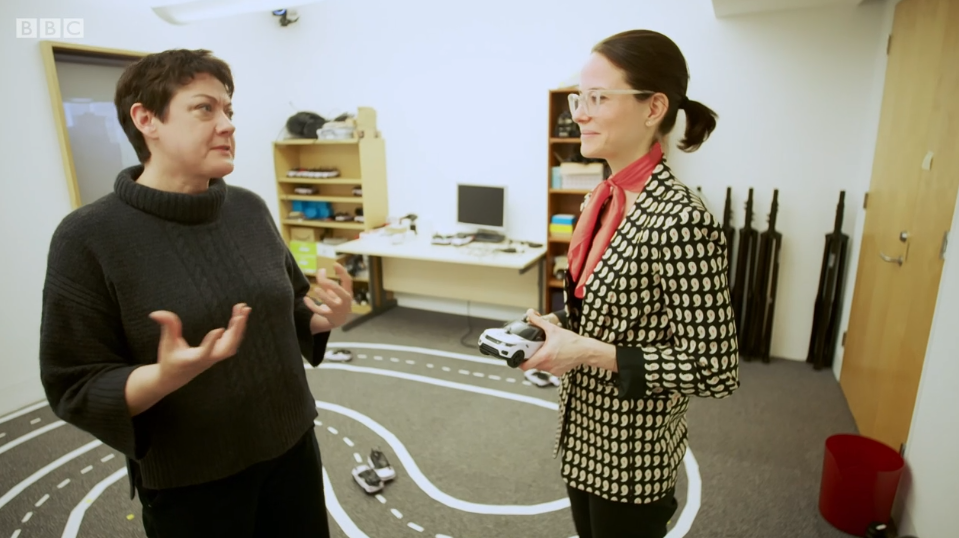
Submitted by Angela Walters on Wed, 22/07/2020 - 14:30
Autonomous navigation is a fiendishly complex challenge, but an innovative team, led by Dr. Amada Prorok, at Cambridge University’s Department of Computer Science and Technology, has made it their mission to find new ways of coordinating artificially intelligent agents, such as autonomous cars, to improve traffic flow.
Their research, partly funded by CDBB, has recently been featured in a BBC documentary ‘Hidden Wilds of the Motorway’. The programme explores the interaction between nature and built environments. Presented by Helen Macdonald, it went out on the 30th June on BBC Four and is available online: https://www.bbc.co.uk/iplayer/episode/m000kjm9/the-hidden-wilds-of-the-motorway.
In the documentary Macdonald marvels at how a flock of lapwings - beautiful black and white marshland birds - weave, twirl and dive as if they were one organism. She observes how the flock is able to achieve a cohesive existence because each individual bird follows a simple set of rules. Intrigued as to whether these rules could be applied to our own overcrowded world, she comes to Cambridge to interview Prorok, a pioneer in taking insights derived from the science of animal swarms and applying them to autonomous navigation.
Amanda Prorok interviewed by Helen Macdonald in the BBC documentary ‘Hidden Wilds of the Motorway’
Prorok explains. “Our inspiration is cooperation. We see how nature can coordinate large groups of animals in very efficient, smooth and elegant ways. If we look at traffic today, we’re not quite there yet.”
Prorok, who was funded as a CDBB Early Career Researcher, and her colleagues, have developed a testbed of 16 miniature robotic cars, all programmed to follow a simple track. Prorok says, “the testbed allowed us to test various driving behaviours in a way that has not been done before.”
In the documentary, viewers are shown an experiment in which Prorok’s robotic cars are programmed with two different algorithms. The first is ‘ego-centric’. Essentially, it mirrors what takes place on our motorways today: there is no co-operation between the cars. When one stops on the inner lane, others are forced to queue behind it, unable to merge in to the outer lane.
Next, the viewers see an alternative ‘co-operative’ algorithm: the cars communicate with each other, sharing their intentions. Instead of queuing, a cooperative Minicar relays its intention to lane-change. Other vehicles reduce their speeds to make space for this projected manoeuvre. As a consequence, traffic flow is maintained, and safety is ensured.
Prorok and her colleagues found that cooperative driving can increase throughput by up to 42 percent and improve traffic flow by 35%. The cars were all sharing the same goal of achieving the highest overall speed and small co-operative adjustments brough benefit to the system as a whole. She says, “If we can get all cars to model that behaviour we would all be getting home a lot quicker.”
Prorok adds, “The idea is not to get rid of drivers. It’s to build as much technology into the systems as needed, in order to help smooth out traffic issues.”
The advantages of cooperative driving have never really been demonstrated in physical setups of this kind and Prorok and her team’s breakthrough research has been recognised with various awards. "Our experimental testbed is unique in its size, scale and cost," Prorok explains. "The Minicar is one out of very few openly available designs; it fills a price-range gap and is especially attractive for robotics labs that already possess telemetry infrastructure, such as motion capture.”
Although the results of their experiments are very promising, they realize the need for further research. There are questions over how the information is going to be shared and where. In future work, the researchers plan to use the fleet to test multi-car systems in more complex scenarios including roads with more lanes, intersections and a wider range of vehicle types.
Dr Prorok has not only looked at how autonomous cars can co-ordinate with each other, but how they interact with their built environment. In research funded by CDBB, https://www.cdbb.cam.ac.uk/co-evolving-built-environments, Dr Prorok and her team have examined what an autonomous vehicle’s dream city would look like. In their research they tried various design layouts and were then able to pinpoint which adjustments resulted in improved navigation. Their goal is to provide actionable recommendations to city planners on how a built environment can support autonomous travel.
We’re at a turning point for mobility. The deployment of connected, automated and autonomous vehicles is going to have a dramatic effect on road transport and the built environment that supports this new technology. Dr Prorok concludes, “As we re-think and re-design our built environments, we have the opportunity to transform them so that autonomous vehicles can navigate efficiently and robustly.”

